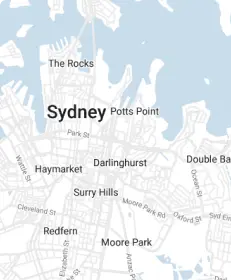If you have a tooth problem or have been told you have cavities, you probably want to know how much does it cost to get a tooth filling in Australia? The short answer is that tooth filling costs anywhere between $115 and $285 according to a recent ADA survey.
The long answer, however, is that there are no standard fees provided by dentists in Australia, meaning a patient may get 10 different prices from 10 different dentists. Nevertheless, to make things a little easier – and as a general rule of thumb – there are several variables which can and do dictate the true cost. So without further ado, let’s dive in and take a closer look at those factors.
Dental clinic locations
It makes perfect sense that a dentist located in one of the major cities such as Sydney or Melbourne is likely to have higher overheads. Did you know that Sydney, for example, is one of the most expensive cities in the world to live? So factors like staff wages, premises rental and even utilities will all have an increased cost attached to them. As such, any ‘extras’ will have to be factored into the cost of dental treatments such as tooth filling, dental check-ups etc and therefore patients will generally pay more, irrespective of what treatment they receive.
What’s more, single-location clinics based right in the heart of the CBD are likely to charge more because of where they are situated as opposed to a dental clinic located a little way out in the suburbs. Therefore it might be worth taking the short drive away from the city where charges for a tooth filling may be slightly less.
Where the problem tooth is located
Another issue that can dictate higher or lower costs is where the problem tooth is located. For example, a distal tooth – the tooth located furthest back in the arch – is likely to be harder to fill than a cuspid/canine tooth – situated just off centre in the smile line.
It also stands to reason that a Class V restoration – those that affect the gingival facial and lingual surfaces of a distal tooth – are going to be more time consuming, than say a class 1 cavity that you can clinically see. Again, all of these factors can and do sway the cost.
Number of tooth surfaces that need filling
Did you know that cavities are among the world’s most common health problems? In fact, according to the latest Governmental Health report for Oral Health and Dental Care, Australians aged 15 and over have on average 12.8 decayed, missing or filled teeth. As a result, multiple cavities are commonplace. It’s also possible to have more than one cavity in the same tooth. So while the average filling takes between 15-20 minutes to complete, time will naturally be added on, the more problem teeth you have. However, any extra time taken is likely to have a sizeable impact on the tooth filling costs involved.
Type of tooth filling?
If you want to know ‘how much does a tooth filling cost’ you’ll need to first have an idea of the type of filling material used. Needless to say, this too can have an impact on the price you pay.
In essence, there are several different types of tooth filling. Don’t worry though if you don’t know enough about them to make an informed dental decision because our No Gaps dental team will talk you through all the alternatives and discuss the best type for you. These depend upon several factors including;
- Patient preference
- Preferred budget
- Location of tooth
- The extent of the repair and,
- Any patient allergies
Tooth fillings include:
Amalgam
More commonly known as silver fillings because of their silver colour, amalgam fillings have been around for a little under 200 years. The first amalgam filling was put to use way back in 1826 and to this day, still provides a cheaper alternative to other materials. On the plus side, they are highly resistant to wear and are often more durable than other materials, lasting on average between 10-15 years.
On the downside, their colour (silver) indicates that they aren’t very aesthetically pleasing and dentists usually limit them to cavities located at the back of the mouth, far away from the smile line.
But perhaps the biggest and most controversial problem is that along with silver, copper and tin, amalgam tooth fillings contain small amounts of mercury. The alloy is needed to act as a binding agent for the other components that collectively, make up the amalgam dental filling.
Naturally, mercury is toxic to humans, however, it is argued that the tiny amounts contained within fillings are insufficient to cause damage. As such, they have been approved safe to use by the Australian Dental Association who continue to support their use.
Composite tooth fillings
Perhaps the most commonly used type of tooth filling in the second decade of the 21st century is the resin-based composite filling. The main advantage of composite fillings is that they are tooth coloured and therefore aesthetically speaking, are far superior to amalgam dental fillings.
They are also more versatile, being used in a variety of clinical situations. Perhaps the biggest advantage is that there are no proven sensitivity/allergy issues with composite white fillings.
That said, some do contain BPA which is a compound added to improve the flexibility of plastic. In some instances, it can affect hormone production. However again, like amalgam fillings, any BPA contained within is utilised in exceptionally small amounts and the ADA fully supports their use.
And their shelf-life?
Structurally, composite fillings aren’t as durable as amalgam tooth fillings and therefore last on average just 5-7 years.
What about the cost?
Composite (white) tooth fillings take longer to place than amalgam fillings and usually require a greater degree of skill. In addition, the materials are also more expensive. As a result, composite fillings are usually more pricey than their amalgam counterparts.
Gold fillings
These are usually custom made in a laboratory before being cemented into place. Because gold fillings contain on average 75% gold, they are very durable and typically last 10-15 years. On the flip side and understandably, they are expensive when compared to amalgam and composite tooth fillings.
Porcelain dental fillings
Porcelain fillings have a similar cost to gold fillings so they don’t come cheap. They also need to be fabricated in a dental lab before being fixed to the tooth. Unlike amalgam and composite fillings, they can’t be applied the same day. However, because they offer the most lifelike of restorations they remain a popular choice of filling.
Porcelain has a translucency just like a natural tooth so it blends in seamlessly. Also, porcelain fillings can easily be coloured to match any existing teeth and are resistant to staining.
So now you know the list of variables that go into a dental filling cost, you’ll also know that to answer the question ‘how much does it cost to get a tooth filling in Australia?’ there isn’t a one-size-fits-all answer.
At No Gaps Dental, we’re a multi-location dental group with 15 clinics scattered in and around the Sydney Metro area including the Chatswood clinic. We pride ourselves on providing quality, family-focused dental care at affordable prices. So, if you require a filling and have a limited budget in mind, come and talk to the No Gaps Dental team at a nearby clinic of your choice.
Call us on 02 8007 6727 or visit our website to book online.






